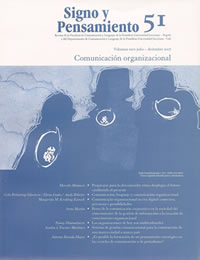Resumen
Este artículo sitúa la comunicación en las organizaciones en el contexto de la complejidad de la sociedad contemporánea. Destaca el poder de las innovaciones tecnológicas de la información y sus impactos sobre las organizaciones. Presenta reflexiones sobre la evolución de la comunicación organizacional desde los llamados flujos informativos a los procesos interactivos y estratégicos presentes hoy en el quehacer comunicacional del mundo corporativo. Analiza la comunidad virtual como un público estratégico relevante y llama la atención sobre la necesidad que tiene la comunicación digital de las organizaciones de adoptar como parámetro la filosofía de la comunicación integrada a través de una adecuada planeación.Esta revista científica se encuentra registrada bajo la licencia Creative Commons Reconocimiento 4.0 Internacional. Por lo tanto, esta obra se puede reproducir, distribuir y comunicar públicamente en formato digital, siempre que se reconozca el nombre de los autores y a la Pontificia Universidad Javeriana. Se permite citar, adaptar, transformar, autoarchivar, republicar y crear a partir del material, para cualquier finalidad (incluso comercial), siempre que se reconozca adecuadamente la autoría, se proporcione un enlace a la obra original y se indique si se han realizado cambios. La Pontificia Universidad Javeriana no retiene los derechos sobre las obras publicadas y los contenidos son responsabilidad exclusiva de los autores, quienes conservan sus derechos morales, intelectuales, de privacidad y publicidad.
El aval sobre la intervención de la obra (revisión, corrección de estilo, traducción, diagramación) y su posterior divulgación se otorga mediante una licencia de uso y no a través de una cesión de derechos, lo que representa que la revista y la Pontificia Universidad Javeriana se eximen de cualquier responsabilidad que se pueda derivar de una mala práctica ética por parte de los autores. En consecuencia de la protección brindada por la licencia de uso, la revista no se encuentra en la obligación de publicar retractaciones o modificar la información ya publicada, a no ser que la errata surja del proceso de gestión editorial. La publicación de contenidos en esta revista no representa regalías para los contribuyentes.


